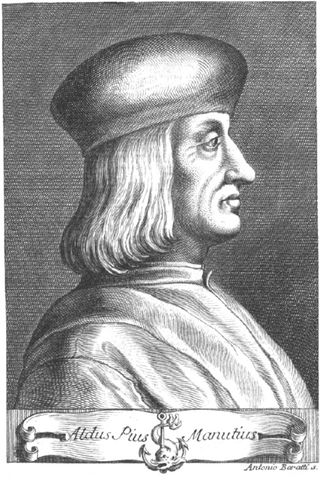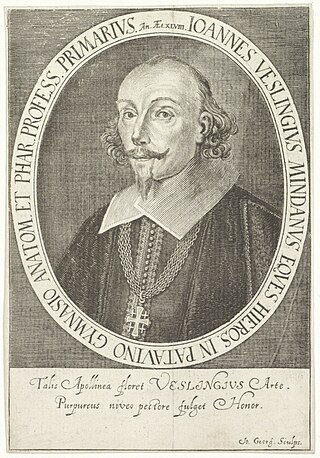Related Research Articles

The Aldine Press was the printing office started by Aldus Manutius in 1494 in Venice, from which were issued the celebrated Aldine editions of the classics. The first book that was dated and printed under his name appeared in 1495.

Alexander of Aphrodisias was a Peripatetic philosopher and the most celebrated of the Ancient Greek commentators on the writings of Aristotle. He was a native of Aphrodisias in Caria and lived and taught in Athens at the beginning of the 3rd century, where he held a position as head of the Peripatetic school. He wrote many commentaries on the works of Aristotle, extant are those on the Prior Analytics, Topics, Meteorology, Sense and Sensibilia, and Metaphysics. Several original treatises also survive, and include a work On Fate, in which he argues against the Stoic doctrine of necessity; and one On the Soul. His commentaries on Aristotle were considered so useful that he was styled, by way of pre-eminence, "the commentator".

Prospero Alpini was a Venetian physician and botanist. He travelled around Egypt and served as the fourth prefect in charge of the botanical garden of Padua. He wrote several botanical treatises which covered exotic plants of economic and medicinal value. His description of coffee and banana plants are considered the oldest in European literature. The ginger-family genus Alpinia was named in his honour by Carolus Linnaeus.
The classical unities, Aristotelian unities, or three unities represent a prescriptive theory of dramatic tragedy that was introduced in Italy in the 16th century and was influential for three centuries. The three unities are:
- unity of action: a tragedy should have one principal action.
- unity of time: the action in a tragedy should occur over a period of no more than 24 hours.
- unity of place: a tragedy should exist in a single physical location.

Ermolao Barbaro, in Latin Hermolaus Barbarus, was a Venetian Renaissance humanist, diplomat and churchman. From 1491, he was the patriarch of Aquileia. He is often called "the Younger" to distinguish him from his cousin, Ermolao Barbaro the Elder.

Aldus Pius Manutius was an Italian printer and humanist who founded the Aldine Press. Manutius devoted the later part of his life to publishing and disseminating rare texts. His interest in and preservation of Greek manuscripts mark him as an innovative publisher of his age dedicated to the editions he produced. Aldus Manutius introduced the small portable book format with his enchiridia, which revolutionized personal reading and are the predecessor of the modern paperback book. He also helped to standardize use of punctuation including the comma and the semicolon.

GiacomoZabarella was an Italian Aristotelian philosopher and logician.

Paul of Venice was a Catholic philosopher, theologian, logician and metaphysician of the Order of Saint Augustine.

Prospero Farinacci was an Italian Renaissance jurist, lawyer and judge. His Praxis et Theorica Criminalis was the strongest influence on criminal law in Civil law countries until the Age of Enlightenment. Farinacci defended Beatrice Cenci who was accused of killing her father in the most famous criminal case of the time. As a judge he was known for his harsh sentencing.

Exoticorum libri decem is an illustrated zoological and botanical compendium in Latin, published at Leiden in 1605 by Charles de l'Écluse.
James of Venice or James the Venetian was a Venetian Catholic cleric who travelled to the Byzantine Empire and was a significant translator of Aristotle during the 12th-Century Renaissance.
The decade of the 1730s in archaeology involved some significant events.

Johann Vesling was a German anatomist and botanist from Minden, Westphalia. He published a major illustrated work on human anatomy Syntagma Anatomicum (1641).
Hoste da Reggio was an Italian composer of the Renaissance, active in Milan and elsewhere in northern Italy. He was well known for his madrigals, which were published in several collections in Venice.
The year 1592 in science and technology involved some significant events.
The year 1533 in science and technology included a number of events, some of which are listed here.
The year 1553 CE in science and technology included a number of events, some of which are listed here.
Johannes Nicolaus Furichius (1602–1633) was a Franco-German Neo-Latin Imperial poet laureate, pharmacist, doctor of medicine and alchemist from Strasbourg.

Melchior Wieland Latinized as Melchior Guilandinus with the Italian form Melchiorre Guilandino was a Prussian botanist and physician who worked in Padua.
References
- ↑ Crilly, Tony (2007). 50 Mathematical Ideas You Really Need to Know. London: Quercus. p. 57. ISBN 978-1-84724-008-8.
- ↑ Stannard, Jerry (1970). "Alpini, Prospero". Dictionary of Scientific Biography . Vol. 1. New York: Charles Scribner's Sons. pp. 124–125. ISBN 0-684-10114-9.